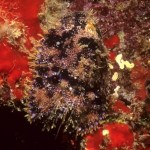camouflage
A camouflaged giant Australian cuttlefish. Image from LiveScience; Credit: Sarah Zylinski, Duke University
Could you imagine artificial skin capable of quickly changing colors to communicate or hide? Scientists have been testing ways to mimic the skin of cephalopods like squid, octopuses and cuttlefish, which have a remarkable ability to change skin color and sometimes even texture to mimic their surroundings. Cephalopods have networks of chromatophores, which are cells within their skin that contain a pigment sac. Expanding these cells with the aid of muscles, makes the pigment…
In the White Sands National Park of New Mexico, there are three species of small lizard that all share white complexions. In the dark soil of the surrounding landscapes, all three lizards wear coloured coats with an array of hues, stripes and spots. Colours would make them stand out like a beacon among the white sands so natural selection has bleached their skins. Within the last few thousand years, the lesser earless lizard, the eastern fence lizard and the little striped whiptail have all evolved white forms that camouflage beautifully among the white dunes.
Erica Bree Rosenblum…
Many animals in the sea have evolved colors and forms that allow them to blend in with their surroundings. Some animals use their camouflage to hide from predators -- and some predators use camouflage to fool their prey.
It can be difficult to photograph such animals, partly because it's often hard to find them in the first place. If you look carefully at the photo at right, you will be able to make out the shape of a small purplish slipper lobster (Parribacus antarcticus), right in the center of the photo.
The picture was taken inside an underwater cave in Hawaii, and the lobster was on…
